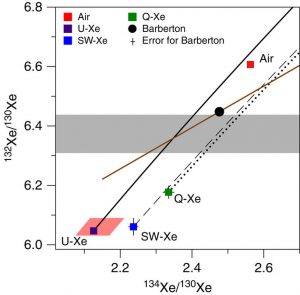The Origin and Degassing History of the Earth’s Atmosphere Revealed by Archean Xenon.
Guillaume Avice, Bernard Marty, and Ray Burgess.
May 2017. Nature Communications 8 : 15455.
doi:10.1038/ncomms15455 (Open Access)
Gases trapped in billion years-old minerals reveal the origin of the Earth’s atmosphere
The mystery of how the Earth’s atmosphere formed has deepened with publication of a new study this week.
Researchers from the CNRS and Université de Lorraine (Nancy, France) and the University of Manchester (UK) have revealed that some of Earth’s atmospheric gases may have been delivered by comets.
“The Earth formed too close to the Sun for volatile elements to easily condense and they would have rapidly boiled off the surface and been lost to space,” said study co-author Prof Ray Burgess, from Manchester’s School of Earth and Environmental sciences. “The reason that oceans and an atmosphere exist at all is because volatiles were still being added after the Earth formed. The puzzle is in identifying where the volatiles came from and what objects carried them to the early Earth. However, the difficulty is that many of the different volatile ingredients that were originally added have been thoroughly mixed together by geological processes during Earth’s long geological history.”
The team analysed tiny samples of ancient air trapped in water bubbles in quartz in drill cores from the Barberton area in South Africa. The rocks here are very old and well preserved. “We measured the amount and isotopic abundance of xenon in the 3.3 billion year old air with unparalleled precision” said lead author Dr Guillaume Avice from Centre de Recherches Pétrographiques et Géochimiques (CRPG; CNRS-Université de Lorraine). “Xenon is a noble gas which, being chemically inert and having nine isotopes, is an ideal element to reveal the xenon isotopic composition in the Earth’s primary atmosphere”. The researchers found that one of the ingredients of ancient air is an enigmatic form of xenon known as U-Xe, this component is not present in the Earth’s mantle, or found in meteorites. They believe that U-Xe must have been added to the Earth after a primordial atmosphere had developed and speculate that comets may be good candidates carrying the U-Xe. Prof Marty, who initiated the study and who is also based as CRPG, commented that: “Our study reveals that 3 Ga ago there was already a xenon component in the Earth’s atmosphere different from solar gases and in asteroids. One possibility is that this Xe was from comets.”
This figure demonstrates how the Archean atmospheric xenon trapped in Barberton quartz can only be produced by mass-related isotopic fractionation (black line) of a starting isotopic composition (pink area) similar to U-Xe (purple square) followed by the addition of xenon from the spontaneous fission of 238U (brown line). More details here.
Dr Avice added that: “The study of gases trapped in ancient rocks opens new perspectives in our understanding of the origin and evolution of Earth’s volatile elements which are keys factors for our planet’s habitability.”

